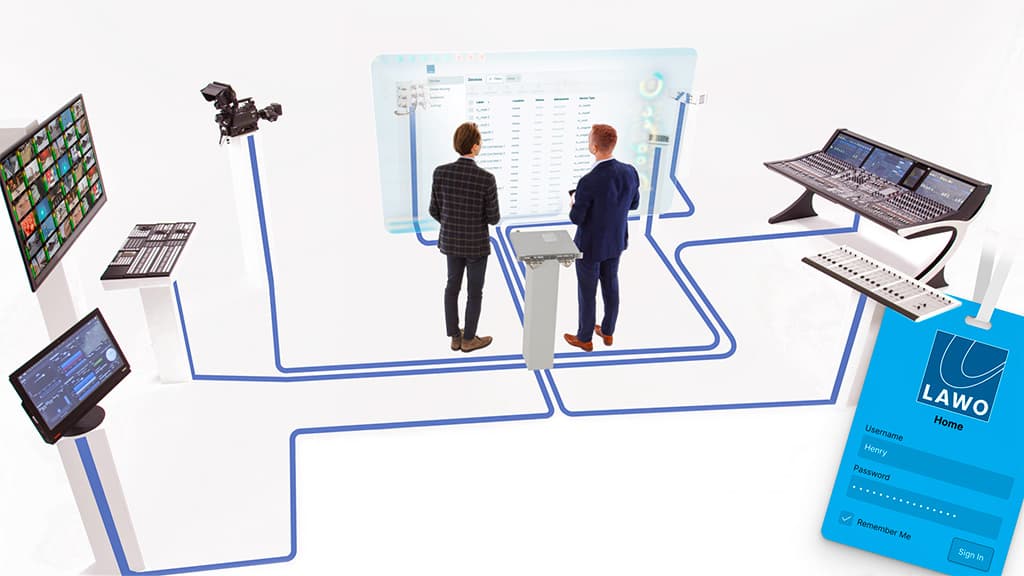
Review: Lawo mc²36
Lawo’s mc² family is now joined by the all-in-one mc²36. Could this be the beginning of a brave new ST2110 world?
Tech Overview: Christopher Holder
You have my permission to bail right now. If you were expecting to read a regular product review, I apologise in advance. But to understand Lawo’s mc²36 you need to wrap your head around a new way of working; a different paradigm.
That said, it’s not a million miles from when Dante first landed in Yamaha’s digital mixing consoles back in 2012.
Prior to that, MADI was king when it came to moving multiple channels of digital audio (and is still a very valid option if point-to-point is all that’s required). Okay, prior to that, Cobranet was a ‘thing’ but not so much in production. And prior to that, digital consoles used traditional analogue snakes and splitters, retaining the conversion stage in the mixer.
Yamaha helped Dante go mainstream, and it was an eyeopener for those working with digital audio — uncompressed audio over a standard IP network brought about an unprecedented level of versatility for moving multi-channel audio around.
Dante is now, arguably, an even bigger deal in the world of installed audio than it is in production. For large (even multi-campus) installations, Dante Domain Manager makes the job of an AV/IT administrator much easier, albeit with a significant pricetag.
ENTER AES67
In the background, while Dante became the defacto digital audio standard, others lobbied for an open IP audio standard or at least a way of allowing different standards like Dante, Q-LAN and Ravenna to talk to each other. The Audio Engineering Society developed the AES67 interoperability standard for IP-based audio networking products. AES67 isn’t trying to compete with Dante or Q-Sys’s Q-LAN, so much, as being a common language for various uncompressed PCM audio network protocols to speak to each other.
SMPTE has also been developing its own open standard for network video and audio. It’s called ST2110 and is now a big deal, especially in the world of broadcast. As broadcasters upgrade their facilities and move away from point-to-point SDI signal transport to IP networks, ST2110 has stepped into the breach.
LAYER 3 SPREE
ST2110 takes full advantage of the flexibility of being a Layer 3 network standard. It moves between subnets without a hitch and the ease with which it multicasts (one input to many outputs without any additional load on the stream’s bandwidth) makes particular sense to the broadcast world — it really is a case of audio going from ‘anywhere to anyone’ without question.
But one of the reasons why people love Dante so much is how easy it is to use. Dante does all the administrative hard work for you. You don’t need to understand IP networks to operate Dante-based gear (but it helps if you’re a system designer, obviously).
ST2110 currently needs IP network knowledge to use.
NEED TO KNOW
Lawo mc²36
Digital Audio Mix System

LAWO & ST2110
A few years back, Lawo saw the future and it was ST2110. Lawo isn’t in the business of selling mixing consoles so much as it is in the supply of networked audio systems, mostly for broadcasters, where mixing consoles are the most visible piece. These systems are almost infinitely customisable, configurable, extremely powerful and pricey.
It makes a lot of sense for Lawo-managed audio to exist in the same ST2110 world as the broadcaster’s video (the ST2110 standards for video are widely adopted). It also makes huge sense to use an open standard that can be endlessly scaleable and flexible, and ensuring Lawo’s destiny is entirely in their own hands and not in Audinate’s, for example.
But it would take a power of work for Lawo to develop a whole new control and management software overlay so that audio engineers can work with Lawo hardware and not just IT engineers.
That software is called Home.

HEADING HOME
Home allows operators to easily discover and configure ST2110 devices on their network. As an audio operator, it might be a 2110 stagebox. That stagebox might be sitting next to you or sitting across the country. Home renders much of the IP networking invisible to the operator.
Lawo’s mc² series of mixing consoles are sophisticated control surfaces. The audio ins and outs, and the DSP aren’t ‘in’ the console, they can be and are mostly somewhere else. I know that’s true of some live sound mixing consoles, to a point, and often a monitor console will share the stagebox with the FOH console. But in a ST2110 world that stagebox is just as easily addressable by that venue’s broadcast studio on the other side of the building, or an OB truck in the carpark, or a remote operator in their living room, interstate.
CASE FOR LAWO
To buy a Lawo console is to buy into the ST2110 ecosystem. Can the mc²36 live in a MADI or Dante world? Yes, but I’d argue that it’s too big an investment to be pushing a square 2110 ‘peg’ into a round Dante ‘hole’.
Apart from broadcasters, such as NEP in Australia and many others worldwide, who is going ‘all in’ with ST2110? No one, is the short answer. But that won’t be true for much longer.
There are three main reasons why larger venues and organisations will be thinking about ST2110 for their audio transport.
- Because they need to upgrade their video transport: ST2110 is becoming a preferred standard for network video and doing the same for audio makes a lot of sense.
- Multi-campus flexibility: Large religious organisations, exhibition centres and education providers, for example, will find the ease in which ST2110 audio moves between subnets and geographical disconnection a real asset.
- Remote production: the pandemic has demonstrated just how important remote production can be to keep the show ‘on the road’. Post-Covid, many venues will want to bake in a remote production backstop if key staff become otherwise unavailable. ST2110 makes remote mixing easy to wrangle.
Finally, an observation: more and more institutions are becoming broadcasters. By which I mean, they’re dealing with media. Video, audio, comms and other content are becoming decreasingly siloed. This is the world that the SMPTE ST2110 IP networking standard is inheriting.
Admittedly, the number of ST2110 edge devices are currently rare as hen’s teeth. Lawo is one of the trailblazers, while Merging Technologies and Direct Out are also releasing some hardware. But if you’re a larger organisation that sees the many advantages of media being available unhindered anywhere in your orbit then you wouldn’t be doing your due diligence without examining the case for a ST2110-based media ecosystem. Chances are, Lawo will be sitting at the top of that particular dossier.































This is a great review- thanks!